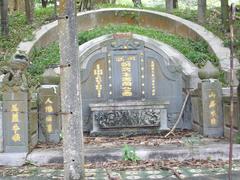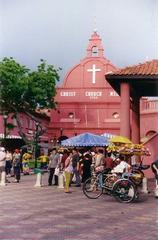
Bukit Cina Malacca, Malaysia: Visiting Hours, Tickets, and Historical Sites Guide
Date: 15/06/2025
Introduction: Understanding Bukit Cina’s Legacy
Bukit Cina, nestled in the heart of Malacca City, is the largest and oldest traditional Chinese cemetery outside China. Beyond its primary role as a sacred burial ground, Bukit Cina represents a convergence of legend, colonial history, and multicultural heritage. Its origins are closely tied to the story of Princess Hang Li Po, who was said to have been sent from the Ming Dynasty to marry Sultan Mansur Shah in the 15th century—a narrative symbolizing the early diplomatic and cultural links between China and the Malaccan Sultanate. While the factual accuracy of this legend is debated, it remains central to Malacca’s local identity and the broader Chinese Malaysian community (Atlas Obscura; World Heritage).
Over the centuries, Bukit Cina transitioned from a royal enclave to a designated cemetery under Dutch administration. With more than 12,000 graves spread across approximately 250,000 square meters, the site is not only a testament to centuries of migration but also to the resilience and integration of the Chinese diaspora in Malaysia. Layers of history, including Portuguese and Dutch influences, as well as its proximity to other religious sites, reflect the rich multicultural and multireligious fabric of Malacca (Lonely Planet; TripVenture).
Today, Bukit Cina is open daily for visitors—free of charge—from 8:00 AM to 6:00 PM and offers guided tours, scenic walking paths, notable temples, and historical wells. Its location near other major attractions further enhances its role as a focal point in any Malacca heritage itinerary (Klook; Holidify).
Table of Contents
- Introduction
- Early Origins and Legendary Foundations
- Evolution into a Chinese Cemetery
- Colonial Influences and Multicultural Heritage
- Notable Features and Landmarks
- Practical Visitor Information
- Nearby Attractions and Cultural Experiences
- Preservation and Modern Challenges
- Frequently Asked Questions (FAQs)
- Conclusion and Traveler Tips
- References
Early Origins and Legendary Foundations
The story of Bukit Cina is inseparable from the legend of Princess Hang Li Po, whose marriage to Sultan Mansur Shah in the 15th century is said to have cemented Malacca’s early ties with China. The Sultan reputedly gifted Bukit Cina to the princess and her entourage, who established their home on the hill (Atlas Obscura). Whether or not the tale is historically accurate, it continues to shape the cultural identity and collective memory of Malacca’s Chinese community (World Heritage).
Evolution into a Chinese Cemetery
Bukit Cina’s transformation from royal residence into a cemetery began in the 17th century. The oldest grave dates to 1612, and in 1685, under Dutch rule, the Kapitan Cina, Lee Wei King, officially purchased the land for use as a cemetery, placing it under the stewardship of the Cheng Hoon Teng Temple (World Heritage; Lakad Pilipinas). The grounds, known as “San Pao Shan” or “Three Gems Hill,” became the final resting place for thousands of Chinese immigrants, with gravestones offering valuable insights into centuries-old customs and social hierarchies.
Colonial Influences and Multicultural Heritage
Successive colonial powers—Portuguese, Dutch, and British—each left their mark on Bukit Cina. The Portuguese established a monastery on the site in the late 16th century, and both European and local figures are buried here, including Muslim warriors like Panglima Pidi (Atlas Obscura). Today, the hill contains not only Chinese graves but also around 20 Muslim graves, emphasizing its multicultural history (World Heritage). Rituals such as the Qingming Festival and Hungry Ghost Festival are still observed, reinforcing the cemetery’s role as a living testament to community identity and tradition (TripVenture; Lakad Pilipinas).
Notable Features and Landmarks
Bukit Cina Cemetery
The cemetery encompasses over 12,000 graves, many adorned with intricate carvings and traditional motifs. The arrangement of the graves along shaded slopes, combined with their sheer number, makes Bukit Cina the largest Chinese cemetery outside China (Penang Travel Tips; Lonely Planet). The site is especially atmospheric during festivals, when families gather to clean graves and make offerings.
Poh San Teng Temple
Located at the foot of Bukit Cina, the Poh San Teng Temple was built in 1795 and is dedicated to Tua Pek Kong, the guardian deity of the land. The temple blends Chinese architecture and local influences, serving as a spiritual and communal anchor for the area (UMK Bukit Cina Case Studies).
Well of Perigi Raja (King’s Well)
Adjacent to Poh San Teng Temple, this historic well was built by the followers of Princess Hang Li Po and has never dried up, even during droughts. It serves as a wishing well and is steeped in local legend (Klook; Wikipedia).
Admiral Zheng He’s Seven Dragon Wells
These wells, dug in the early 15th century by Admiral Zheng He’s fleet, are said to have been constructed according to feng shui principles. Three of the original seven remain, and they are a significant feature of the lower slopes of Bukit Cina (Wikipedia).
Scenic Trails and City Views
The natural beauty of Bukit Cina, with its forested slopes and panoramic city views, invites both reflective walks and recreational activities. Early mornings and late afternoons are ideal for photography and enjoying the tranquil ambiance (Klook).
Practical Visitor Information
- Location: Kampung Bukit China, 75100 Malacca, Malaysia (Lonely Planet).
- Visiting Hours: 8:00 AM–6:00 PM daily. Poh San Teng Temple: 9:00 AM–5:00 PM.
- Entry Fees: Free entry for all visitors to the cemetery, temple, and wells (Holidify; Malaysia Traveller).
- Accessibility: While paved paths are available, some cemetery areas are uneven and may be challenging for visitors with mobility concerns.
- Transport: Easily accessible by car, taxi, local bus, or on foot from the city center. Bicycle rentals and trishaws are also popular options (Fair Dinkum Traveller).
- Facilities: Restrooms and refreshments are available at nearby cafes and restaurants; limited facilities on-site.
- Dress Code and Etiquette: Modest attire recommended; behave respectfully as it is an active cemetery and temple. Photography is permitted, but avoid close-ups of graves or ceremonies (Klook).
Nearby Attractions and Cultural Experiences
Bukit Cina’s central location places it near other key heritage sites:
- Cheng Hoon Teng Temple: Malaysia’s oldest Chinese temple.
- St. Peter’s Church: One of Southeast Asia’s oldest churches.
- Jonker Street: Vibrant market and shophouse district.
- Dutch Square (Stadthuys): Dutch colonial buildings and museums.
- Baba & Nyonya Heritage Museum: Insight into Peranakan culture.
Pairing your Bukit Cina visit with these attractions provides a comprehensive Malacca heritage experience (Lonely Planet; The Crazy Tourist).
Preservation and Modern Challenges
In the 1980s, redevelopment threats to Bukit Cina sparked strong opposition, leading to its preservation as a heritage site through community advocacy (Atlas Obscura; Geographical Review via JSTOR). Today, Bukit Cina is maintained through civic engagement, educational programs, and community-led initiatives, but ongoing challenges include urban encroachment and environmental pressures (UMK Bukit Cina Case Studies).
Frequently Asked Questions (FAQs)
Q: What are Bukit Cina’s visiting hours?
A: Daily from 8:00 AM to 6:00 PM.
Q: Is there an entrance fee?
A: No, entry is free.
Q: Are guided tours available?
A: Yes, local tour operators and apps such as Klook offer guided experiences.
Q: Is Bukit Cina wheelchair accessible?
A: Some areas are accessible, but uneven terrain may pose challenges.
Q: When is the best time to visit?
A: Early mornings or late afternoons on weekdays offer fewer crowds and cooler weather.
Conclusion and Traveler Tips
Bukit Cina is a profound symbol of Malacca’s multicultural past and the resilience of the Chinese Malaysian community. Its extensive cemetery, historic temples, and legendary wells provide a tangible link to centuries of heritage. Free entry, central location, and proximity to other attractions make it a must-visit for history buffs and cultural explorers alike.
Travel Tips:
- Wear comfortable shoes and bring water, especially in warm weather.
- Respect local customs and the sanctity of the site.
- Consider a guided tour for deeper insights.
- Plan your route to include nearby heritage sites for a full day’s exploration.
For enhanced experiences, download the Audiala app for guided tours, interactive maps, and the latest updates on Malacca’s historical attractions.
References
- Atlas Obscura: Bukit Cina
- World Heritage: Bukit Cina - A Hill Steeped in Legend and History
- Lakad Pilipinas: Bukit Cina Melaka Malaysia
- TripVenture: Bukit Cina Malacca City Malaysia Attractions
- Penang Travel Tips: Bukit Cina Visiting Hours, Tickets, and Cultural Significance
- UMK Bukit Cina Case Studies
- Holidify: Bukit Cina Visiting Hours, Tickets & Guide
- Klook: Bukit Cina Malacca City Attractions
- Lonely Planet: Bukit Cina Malacca City
- Malaysia Traveller: Bukit Cina Historical and Cultural Guide
- Geographical Review via JSTOR



